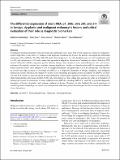Files in this item
The differential expression of micro-RNAs 21, 200c, 204, 205, and 211 in benign, dysplastic and malignant melanocytic lesions and critical evaluation of their role as diagnostic biomarkers
Item metadata
| dc.contributor.author | Quiohilag, Katherine | |
| dc.contributor.author | Caie, Peter | |
| dc.contributor.author | Oniscu, Anca | |
| dc.contributor.author | Brenn, Thomas | |
| dc.contributor.author | Harrison, David | |
| dc.date.accessioned | 2020-05-25T15:30:04Z | |
| dc.date.available | 2020-05-25T15:30:04Z | |
| dc.date.issued | 2020-05-09 | |
| dc.identifier | 268138679 | |
| dc.identifier | 68b10981-7415-4ead-94f5-4ef153db3bfa | |
| dc.identifier | 85084517717 | |
| dc.identifier | 32388720 | |
| dc.identifier | 000531216100001 | |
| dc.identifier.citation | Quiohilag , K , Caie , P , Oniscu , A , Brenn , T & Harrison , D 2020 , ' The differential expression of micro-RNAs 21, 200c, 204, 205, and 211 in benign, dysplastic and malignant melanocytic lesions and critical evaluation of their role as diagnostic biomarkers ' , Virchows Archiv , vol. First Online . https://doi.org/10.1007/s00428-020-02817-5 | en |
| dc.identifier.issn | 0945-6317 | |
| dc.identifier.other | ORCID: /0000-0001-9041-9988/work/74873026 | |
| dc.identifier.other | ORCID: /0000-0002-0031-9850/work/74873056 | |
| dc.identifier.uri | https://hdl.handle.net/10023/19991 | |
| dc.description.abstract | Overlapping histological features between benign and malignant lesions and a lack of firm diagnostic criteria for malignancy result in high rates of inter-observer variation in the diagnosis of melanocytic lesions. We aimed to investigate the differential expression of five miRNAs (21, 200c, 204, 205, and 211) in benign naevi (n = 42), dysplastic naevi (n = 41), melanoma in situ (n = 42), and melanoma (n = 42) and evaluate their potential as diagnostic biomarkers of melanocytic lesions. Real-time PCR showed differential miRNA expression profiles between benign naevi; dysplastic naevi and melanoma in situ; and invasive melanoma. We applied a random forest machine learning algorithm to classify cases based on their miRNA expression profiles, which resulted in a ROC curve analysis of 0.99 for malignant melanoma and greater than 0.9 for all other groups. This indicates an overall very high accuracy of our panel of miRNAs as a diagnostic biomarker of benign, dysplastic, and malignant melanocytic lesions. However, the impact of variable lesion percentage and spatial expression patterns of miRNAs on these real-time PCR results was also considered. In situ hybridisation confirmed the expression of miRNA 21 and 211 in melanocytes, while demonstrating expression of miRNA 205 only in keratinocytes, thus calling into question its value as a biomarker of melanocytic lesions. In conclusion, we have validated some miRNAs, including miRNA 21 and 211, as potential diagnostic biomarkers of benign, dysplastic, and malignant melanocytic lesions. However, we also highlight the crucial importance of considering tissue morphology and spatial expression patterns when using molecular techniques for the discovery and validation of new biomarkers. | |
| dc.format.extent | 10 | |
| dc.format.extent | 849085 | |
| dc.language.iso | eng | |
| dc.relation.ispartof | Virchows Archiv | en |
| dc.subject | Dermatopathology | en |
| dc.subject | Melanoma | en |
| dc.subject | microRNA | en |
| dc.subject | Molecular pathology | en |
| dc.subject | RB Pathology | en |
| dc.subject | Pathology and Forensic Medicine | en |
| dc.subject | Molecular Biology | en |
| dc.subject | Cell Biology | en |
| dc.subject | DAS | en |
| dc.subject.lcc | RB | en |
| dc.title | The differential expression of micro-RNAs 21, 200c, 204, 205, and 211 in benign, dysplastic and malignant melanocytic lesions and critical evaluation of their role as diagnostic biomarkers | en |
| dc.type | Journal article | en |
| dc.contributor.institution | University of St Andrews. Sir James Mackenzie Institute for Early Diagnosis | en |
| dc.contributor.institution | University of St Andrews. Centre for Biophotonics | en |
| dc.contributor.institution | University of St Andrews. Cellular Medicine Division | en |
| dc.contributor.institution | University of St Andrews. School of Medicine | en |
| dc.identifier.doi | https://doi.org/10.1007/s00428-020-02817-5 | |
| dc.description.status | Peer reviewed | en |
This item appears in the following Collection(s)
Items in the St Andrews Research Repository are protected by copyright, with all rights reserved, unless otherwise indicated.

